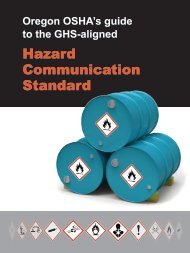Technical Manual - Section 3 (Safety Hazards)
Technical Manual - Section 3 (Safety Hazards)
Technical Manual - Section 3 (Safety Hazards)
Create successful ePaper yourself
Turn your PDF publications into a flip-book with our unique Google optimized e-Paper software.
Table III:2-21. STEAM REFORMING PROCESS<br />
Feedstock From Process Typical products.....................To<br />
Desulfurized Various Decomposition Hydrogen.................................Processing<br />
refinery gas treatment Carbon dioxide........................Atmosphere<br />
units<br />
Carbon monoxide....................Methane<br />
remove sulfur compounds, the feedstock is mixed with steam<br />
and taken to the reforming furnace (1,250-1,500º F) where<br />
hydrogen is produced.<br />
HEALTH AND SAFETY CONSIDERATIONS<br />
Fire Protection and Prevention<br />
The possibility of fire exists should a leak or release occur<br />
and reach an ignition source.<br />
<strong>Safety</strong><br />
The potential exists for burns from hot gases and superheated<br />
steam should a release occur. Inspections and testing should<br />
be considered where the possibility exists for valve failure<br />
due to contaminants in the hydrogen. Carryover from caustic<br />
scrubbers should be controlled to prevent corrosion in<br />
preheaters. Chlorides from the feedstock or steam system<br />
should be prevented from entering reformer tubes and<br />
contaminating the catalyst.<br />
Health<br />
Because these are closed processes, exposures are expected<br />
to be minimal during normal operating conditions. There is a<br />
potential for exposure to excess hydrogen, carbon monoxide,<br />
and/or carbon dioxide. Condensate can be contaminated by<br />
process materials such as caustics and amine compounds,<br />
with resultant exposures. Depending on the specific process<br />
used, safe work practices and/or appropriate personal<br />
protective equipment may be needed for exposures to<br />
chemicals and other<br />
hazards such as noise and heat, and during process sampling,<br />
inspection, maintenance, and turnaround activities.<br />
BLENDING<br />
Blending is the physical mixture of a number of different<br />
liquid hydrocarbons to produce a finished product with<br />
certain desired characteristics. Products can be blended<br />
in-line through a manifold system, or batch blended in tanks<br />
and vessels. In-line blending of gasoline, distillates, jet fuel,<br />
and kerosene is accomplished by injecting proportionate<br />
amounts of each component into the main stream where<br />
turbulence promotes thorough mixing. Additives including<br />
octane enhancers, metal deactivators, anti-oxidants,<br />
anti-knock agents, gum and rust inhibitors, detergents, etc. are<br />
added during and/or after blending to provide specific<br />
properties not inherent in hydrocarbons.<br />
HEALTH AND SAFETY CONSIDERATIONS<br />
Fire Prevention and Protection<br />
Ignition sources in the area need to be controlled in the event<br />
of a leak or release.<br />
Health<br />
Safe work practices and/or appropriate personal protective<br />
equipment may be needed for exposures to chemicals and<br />
other hazards such as noise and heat; when handling<br />
additives; and during inspection, maintenance, and<br />
turnaround activities.<br />
III:2-47
















